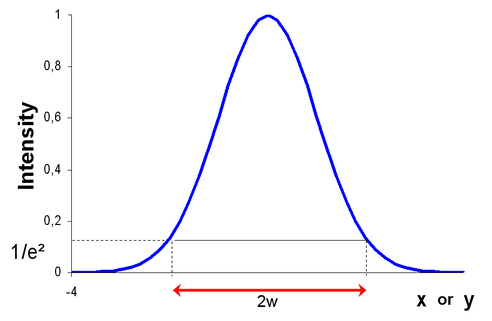
Spherical Gaussian wave
We will now introduce here a generalization for the solutions of the Helmoltz equation. The physical signification of those solution will be explain afterwards.
For the solutions of the Helmholtz equation corresponding to paraxial beams along the z-direction, we can write :
where
 is a complex function representing the difference between a laser beam ansd an homogeneous plane wave.
is a complex function representing the difference between a laser beam ansd an homogeneous plane wave.
If we replace this solution in the Helmholtz equation, with the additionnal hypothesis that the variations of
 in the z-direction are small over a distance comparable to the wavelength (that is
in the z-direction are small over a distance comparable to the wavelength (that is
 and
and
 ), we can write the paraxial wave equation in the following form :
), we can write the paraxial wave equation in the following form :
This equation is similar to the Schrödinger wave equation describing a free particule in a 2D space (just replace the time t by the spatial coordinate z).
The solution of the paraxial wave equation are well-known. We can thus easily check that the following function (among others) is a solution :
with :
-
 is a complex phase difference.
is a complex phase difference.
-
q(z) represents a complex radius of curvature, or in other words the transverse variation of the amplitude and the wavefront curvature.
This specific solution, called “fundamental Gaussian mode”, is actually the most important for laser resonators. We will study later this mode more specifically.
By substituting the expression for
 in the paraxial wave equation, we obtain that for any (x,y) :
in the paraxial wave equation, we obtain that for any (x,y) :
We deduce then that q(z) and
 must verify :
must verify :
If we write

Then
where the “0” indexes correspond to the values for z=0. If we choose the origin so that the curvature radius is infinite (plane wave) at this point, we have
 . We can then easily show that :
. We can then easily show that :
After identification of this relation with
 we conclude that :
we conclude that :
Moreover :
Finally, if we gather all those equations, we get the fundamental expression of the spherical Gaussian wave :
with :
-
K/w(z) is a normalization factor
-
the first exponential function is the propagation factor
-
the second exponential function is a phase difference sometimes called « Guoy » phase shift
-
the third exponential function could be broken up in a “spherical wave” factor and a “Gaussian” factor, by replacing q with its expression as a function of R :
where we have used cylindrical coordinates (r²=x² + y²).
Here we see the Gaussain shape of the transverse profile of the wave for any z position. The intensity profile (proportional to the square of the field amplitude) is then (see figure 10) :

-
 is the radius of curvature of the wavefront at the z abscissa.
is the radius of curvature of the wavefront at the z abscissa.
-
 is a measure of the Gaussian decrease of the field amplitude with the distance relative to the z-axis (see figure 10). The parameter w is the distance for which the amplitude is equal to 1/e times (1/e² if we consider the intensity) its value for (x,y) = (0,0)
is a measure of the Gaussian decrease of the field amplitude with the distance relative to the z-axis (see figure 10). The parameter w is the distance for which the amplitude is equal to 1/e times (1/e² if we consider the intensity) its value for (x,y) = (0,0)
w is minimal when z=0, where the radius of curvature is infinite. Its value at the origin is written w0 and defines the “waist” of the beam.
-
 is a very convenient parameter called “Rayleigh length” and is related to the beam divergence (see later).
is a very convenient parameter called “Rayleigh length” and is related to the beam divergence (see later).
We also remind the following relations :
-
 and
and
 is the Guoy phase shift.
is the Guoy phase shift.
-
This phase difference means that the phase of the Gaussian wave is shifted by a quantity
 on the z-axis relatively to a plane wave of the same wavelength that have left the z=0 point at the same moment. The wave undergoes a global phase shift of
on the z-axis relatively to a plane wave of the same wavelength that have left the z=0 point at the same moment. The wave undergoes a global phase shift of
 when passing through z=0.
when passing through z=0.
